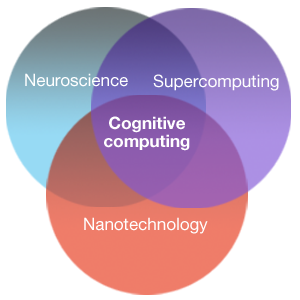Semantic search functionality (Cognitive computing) and social media data UIMA, NLP, Elasticsearch/Solr How to teach computers to observe, evaluate and decide.

Consider an example from our daily life. When we enter into an unfamiliar dark room, and try to turn on the light, our memory informs us the most likely place in a room a light switch can be at. This memory is created from the reminder of several repeated past incidents when we had switched on lights in darkened rooms. We reach at the place in the dark room where the switch is to be found possibly, and we almost certainly find it. Human brain is an assemblage of associational activities. The brain gathers associational attributes that connect various data entities, and then collect them into common frameworks where these associations appear.
Cognitive computing platform is built in much of the same manner. “The technology actively learns ‘patterns’ of association and then reasons based upon what it has learned from these associational patterns.”
Cognitive computing platform implements machine learning algorithms and repeatedly acquire memory from the data provided to them by mining data for information. The systems perfect the approach they try to find patterns along with the approach they process data so that they are adept in anticipating new problems and forming likely solutions.
UMAI (Unstructured Information Management Applications) is an open source framework that studies huge volume of unstructured information (e.g., text, speech) to determine knowledge that is relevant to an end user. UIMA furthermore is responsible for competencies to wrap components as network services, and can scale to very large volumes by replicating processing pipelines over a cluster of networked nodes.
Solr is very consistent, accessible and error tolerant, that provides disseminated indexing, replication and load-balanced querying, instinctive failover and recovery, central formation among others. Solr impacts the pursuit and navigation features of various major internet sites of the world. Solr is rightly open-source-community over code. Everyone can contribute to Solr. A novice Solr developer (aka committers) is chosen based on excellence. Elasticsearch is only theoretically open-source. Everybody can view the source, every may contribute to its changes, but only employees of Elasticsearch can in reality make variations to Elasticsearch.
A challenge before the approach is, human can easily comprehend fellow human’s emotion, but can a machine be trained to do so? To detect the emotion of the persons involved in the conversation, the transcript of such conversation needs to be made. Then the emotions involved should be classified under normal or neutral?? and agitated or excited??. Then, the probability of whether the conversation as successful or not is computed.
The aim of the Natural Language Processing (NLP) algorithm is to design and build software that can be able to analyse, comprehend, and create languages that can be used by the humans naturally, in such a manner that humans will be able to communicate with the computers as though they were communicating to other humans and vice versa.
